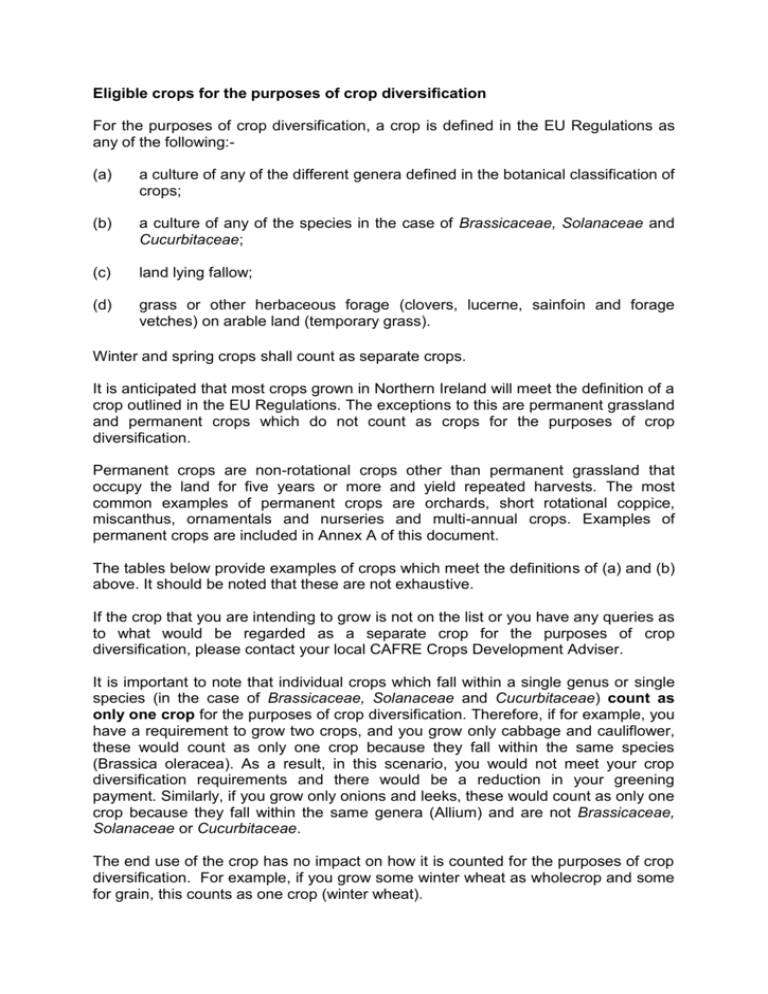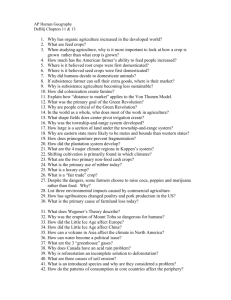Information about the eligibility of crops for crop diversification Word
advertisement

Eligible crops for the purposes of crop diversification For the purposes of crop diversification, a crop is defined in the EU Regulations as any of the following:(a) a culture of any of the different genera defined in the botanical classification of crops; (b) a culture of any of the species in the case of Brassicaceae, Solanaceae and Cucurbitaceae; (c) land lying fallow; (d) grass or other herbaceous forage (clovers, lucerne, sainfoin and forage vetches) on arable land (temporary grass). Winter and spring crops shall count as separate crops. It is anticipated that most crops grown in Northern Ireland will meet the definition of a crop outlined in the EU Regulations. The exceptions to this are permanent grassland and permanent crops which do not count as crops for the purposes of crop diversification. Permanent crops are non-rotational crops other than permanent grassland that occupy the land for five years or more and yield repeated harvests. The most common examples of permanent crops are orchards, short rotational coppice, miscanthus, ornamentals and nurseries and multi-annual crops. Examples of permanent crops are included in Annex A of this document. The tables below provide examples of crops which meet the definitions of (a) and (b) above. It should be noted that these are not exhaustive. If the crop that you are intending to grow is not on the list or you have any queries as to what would be regarded as a separate crop for the purposes of crop diversification, please contact your local CAFRE Crops Development Adviser. It is important to note that individual crops which fall within a single genus or single species (in the case of Brassicaceae, Solanaceae and Cucurbitaceae) count as only one crop for the purposes of crop diversification. Therefore, if for example, you have a requirement to grow two crops, and you grow only cabbage and cauliflower, these would count as only one crop because they fall within the same species (Brassica oleracea). As a result, in this scenario, you would not meet your crop diversification requirements and there would be a reduction in your greening payment. Similarly, if you grow only onions and leeks, these would count as only one crop because they fall within the same genera (Allium) and are not Brassicaceae, Solanaceae or Cucurbitaceae. The end use of the crop has no impact on how it is counted for the purposes of crop diversification. For example, if you grow some winter wheat as wholecrop and some for grain, this counts as one crop (winter wheat). Similarly, the end use of grass has no impact on how it is counted for the purposes of crop diversification. For example, if a farmer grows grass and uses some for forage and some for anaerobic digestion, this will count as one crop (grass), provided it is not permanent grassland. The growing of a seed mixture or a number of different seed mixtures will count as one crop. Therefore, if you grow two or more different seed mixtures, this will count as one crop. Examples of crops in (a) above, i.e. culture of any of the different genera defined in the botanical classification of crops Crop Name Genus Includes Barley Hordeum Feed barley, Malting barley, Two row barley, Six row barley Basil Ocimum All Basils Beet Beta Beetroot, Chard, Field Beet, Fodder Beet, Mangolds, Redbeet,Sugar Beet Carrot Daucus Carrot Celeriac Apium Celeriac, Celery Chicory Chichorium Chicory, Endive, Radiccio, Italian Chicory Dill Anethum Dill Fennel Foeniculum Fennel Field Beans Vicia Broad beans, Field beans, Tic beans Green Beans Phaseolus French beans, Green beans, Haricot beans, Runner beans Hemp (grown as an energy crop) Cannabis Hemp Lettuce Lactuca Lettuce, Romaine lettuce, Cos lettuce, Iceberg lettuce, Butterhead lettuce Linseed Linum Linseed, Flax Lupins Lupinus Lupins Maize Zea Maize, Corn, Sweetcorn Marjoram Origanum Marjoram, Oregano Oats Avena Oats, Quaking oats, Porridge oats, Feed oats, Naked oats Onions Allium Onions, Shallots, Garlic, Leeks, Chives, Scallions, Spring onions Parsley Petroselinum All parsleys Parsnips Pastinaca Parsnips Peas Pisum Feed pea, Mange tout, Marrow fat pea, Snap pea, Snow pea, Vining pea Rye Secale Rye, Winter Rye (for cover) Spinach Spinacia Spinach Strawberry Fragaria Strawberries Sunflower Helianthus Sunflowers Sweet Potato Ipomoea Sweet potato Triticale Triticosecale Triticale Triticum Biscuit wheat, Common or Bread wheat, Durum wheat, Einkorn, Feed wheat, Red wheat, Spelt Wheat Examples of crops in (b) above, i.e. a culture of any of the species in the case of Brassicaceae, Solanaceae and Cucurbitaceae. Brassicaceae Crop Name Species Includes Cabbage Brassica oleracea Broccoli, Brussels sprouts, Cabbages, Calabrese, Cauliflower, Chinese kale, Kale, Kohlrabi, Red cabbage, Savoy cabbage, White cabbage Rapeseed Brassica napus Industrial rape, Oilseed rape, Swede Radish Raphanus sativus Radish Brassica rapa Bok choi, Chinese cabbage (Pak choi), Turnip, Turnip rape Crop Name Species Includes Aubergine Solanum melongena Aubergine, Eggplant Chilli Capsicum baccatum Bishop's crown chilli, Lemon drop chilli, Peppadew chilli Pepper Capsicum annuum Bell pepper, Chilli pepper Potato Solanum tuberosum Early potato, Maincrop potato, Seed potato Tomato Solanum lycopersicum Tomato Tree Chilli Capsicum pubescens Tree Chilli Species Includes Turnip Solanaceae Cucurbitacae Crop Name Butternut Squash Cucurbita moschata Butternut squash, Cheese pumpkin Cucumber Cucumis sativus Cucumber Cucurbita pepo Pumpkins, Squashes, Marrows, Zucchini, Courgettes Squash Annex A Examples of Permanent Crops Permanent crops are non-rotational crops other than permanent grassland that occupy the land for five years or more and yield repeated harvests. The most common examples of permanent crops are orchards, short rotational coppice, miscanthus, ornamentals and nurseries, and multi-annual crops. As outlined above, permanent crops do not count as crops for the purposes of crop diversification. Examples of permanent crops include the following (please note that the examples provided below are not exhaustive):- Almonds Grapes Peaches Apples Guavas Pears Apricots Hazelnuts Pecans Artichoke Hops Pineapples Asparagus Horseradish Pine nuts Avocados Lavender Pistachios Bilberries Loganberries Plums Blackberries Macadamia nuts Raspberries Cherries Mangos Reed canary grass Chestnuts Mangosteens Rhubarb Citrus fruit Melissa Rosemary Cranberries Mint Sloes and Quinces Currants Miscanthus Walnuts Mulberries Figs Gooseberries Papayas and Locust Beans Notes: 1. Other fruits under the genus ‘Vaccinium’ are also permanent crops. 2. Strawberries are not permanent crops and are classified as an arable use. Consequently, strawberries are an eligible crop for the purposes of crop diversification. Nursery Crops Nursery crops are areas of young woody plants grown in the open air, on soil in greenhouses or under polytunnels for later transportation. These cannot be used as a crop for crop diversification purposes. Examples of nursery crops include the following: Vine and root stock nurseries Fruit tree nurseries Ornamental nurseries Commercial nurseries of forest trees (excluding those for the holding’s own requirements grown in woodland) Nurseries of trees and bushes for planting in gardens, parks, at the roadside and on embankments Short Rotation Coppice The list of tree species which can be used for short rotation coppice to secure direct payments are listed below. The maximum harvest cycle is 5 years. These cannot be used as a crop for crop diversification purposes. Alder Ash Birch Hazel Lime Poplar Sweet chestnut Sycamore Willow







